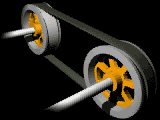Belt (Mechanical)
Introduction
Belts are used for transmitting power between two shafts. Belts will be of two kinds, flat and vee belts. Belts are running over the pulleys which are mounted on two shafts. Belts are used when the distance between the shafts is large. Gears are used when the distance between the shafts is small.
Types of Belts
- Flat Belt - This belt has a rectangular cross section as shown in fig 1. (a) . These belts are capable of transmitting power over long distances between pulley centres. The efficiency of this drive is around 98% and produce little noise.
- V Belt - This belt is used with grooved pulleys, V-belts are trapezoidal in cross-section as shown in fig 1. (b). This belt permit large speed ratio and can transmit higher power.
- Circular Belt - This type of belt has a circular cross-section as shown in fig 1.(c). and is used with the grooved pulleys.
Types of Belt Drive
Open Belt drive
Cross Belt drive
Compound Belt drive
Open Belt drive
Open Belt drive consists of two pulleys A and B in fig 2. Driver pulley is the pulley which is keyed to the rotating shaft. Driven pulley is the pulley which is keyed to the shaft and to be rotated. Here Driver pulley is pulley A and Driven pulley is pulley B.
The mechanical power or rotary motion is transmitted from the driving pulley to the driven pulley because of the frictional grip that exists between the belt and the pulley surface.
The driver pulley A pulls the belt from the lower side and delivers it to the upper side. Thus the tension in the lower side of the belt will be more than the tension in the upper side. Lower side is called as tight side and the upper side is called as the slack side.
Sometimes in a belt-drive, there is always a possibility of some slipping taking place between the belt and the pulleys which cause the driven pulley to rotate at a lesser speed, consequently reduces the power transmission. Hence belt drives are said to be not a Positive type of power transmission system
Velocity Ratio :
Velocity ratio is the ratio of the velocity of the driven to the velocity of the driver.
Let N1= Speed of the driver in r.p.m ; d1= Diameter of the driver
N2= Speed of the driven in r.p.m ; d2= Speed of the driven
Length of the belt passing over the driver in one minute = circumference of the driver X number of revolutions per minute
= π d1 X N1
Length of the belt passing over the driven in one minute = circumference of the driven X number of revolutions per minute
= π d2 X N2
Length of the belt passing over the driver in one minute = Length of the belt passing over the driven in one minute
π d1 X N1 = π d2 X N2
Velocity ration is --------- equation (1)
Cross Belt drive
In an open belt drive both the pulleys rotate in the same direction, where as in cross belt drive the pulleys rotate in the opposite direction.
The driver pulley A in fig 3. pulls the belt from CD side and delivers it to FE side. Thus the tension in the belt CD will be more than that in the belt FE. CD side is known as tight side and FE side is known as slack side.
Compound Belt Drive
Compound Belt drive is used when the power is to be transmitted from one shaft to another through a number of pulleys. In fig 4. shows Compound belt drive where in pulley 1 drives the pulley 2 . Pulleys 2 and 3 are fixed to the same shaft, hence the pulley 1 drives pulley 3 also. Pulley 3 drives the pulley 4.
Velocity Ratio of Compound Belt drive.
Velocity ratio is the ratio of the velocity of the driven to the velocity of the driver.
Let N1= Speed of the pulley 1 in r.p.m ; d1= Diameter of the pulley 1
N2= Speed of the pulley 2 in r.p.m ; d2= Speed of the pulley 2
N3= Speed of the pulley 3 in r.p.m ; d3= Speed of the pulley 3
N4= Speed of the pulley 4 in r.p.m ; d4= Speed of the pulley 4
From equation (1) Velocity ratio of pulleys 1 and 2 is
------- (i)
Similarly Velocity ratio of pulleys 3 and 4 is
-------- (ii)
Multiplying the equations (i) and (ii)
N2 = N3 as the pulleys 2 and 3 are fixed to the same shaft.
which is
